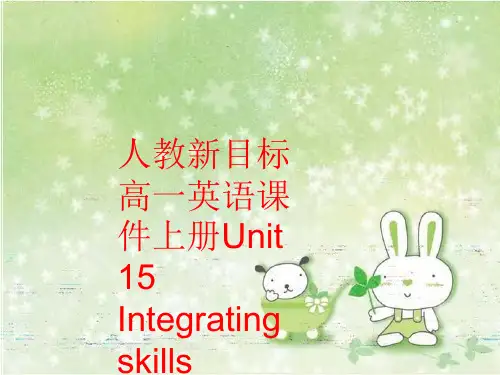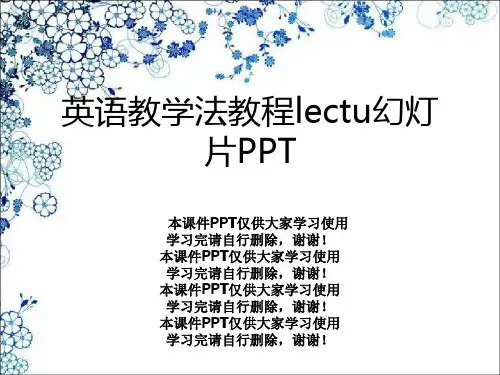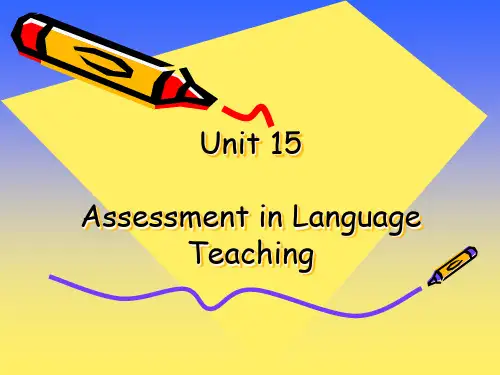英语教学法教程PPT教学课件-Unit 15
- 格式:ppt
- 大小:304.50 KB
- 文档页数:8

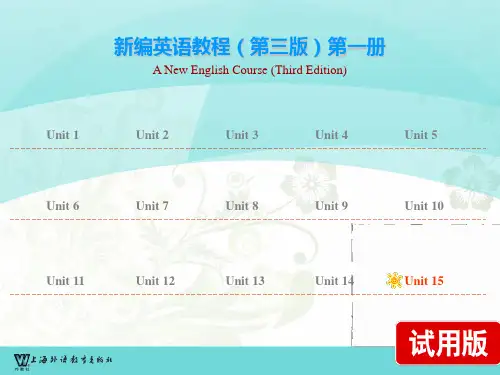

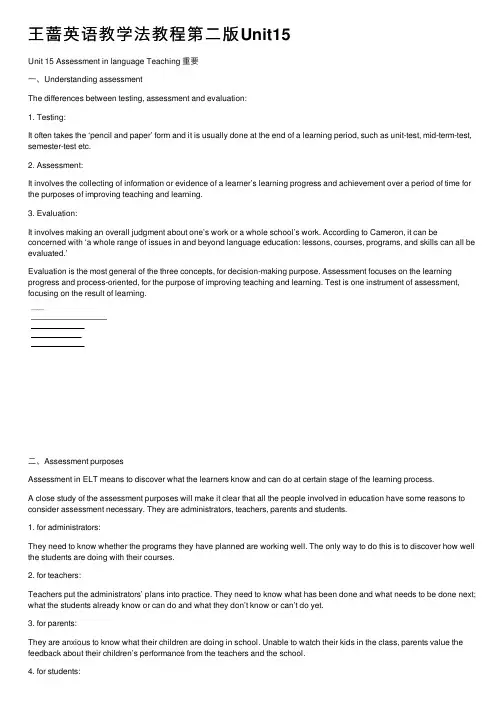
王蔷英语教学法教程第⼆版Unit15Unit 15 Assessment in language Teaching 重要⼀、Understanding assessmentThe differences between testing, assessment and evaluation:1. Testing:It often takes the ‘pencil and paper’ form and it is usually done at the end of a learning period, such as unit-test, mid-term-test, semester-test etc.2. Assessment:It involves the collecting of information or evidence of a learner’s learning progress and achievement over a period of time for the purposes of improving teaching and learning.3. Evaluation:It involves making an overall judgment about one’s work or a whole school’s work. According to Cameron, it can be concerned with ‘a whole range of issues in and beyond language education: lessons, courses, programs, and skills can all be evaluated.’Evaluation is the most general of the three concepts, for decision-making purpose. Assessment focuses on the learning progress and process-oriented, for the purpose of improving teaching and learning. Test is one instrument of assessment, focusing on the result of learning.⼆、Assessment purposesAssessment in ELT means to discover what the learners know and can do at certain stage of the learning process.A close study of the assessment purposes will make it clear that all the people involved in education have some reasons to consider assessment necessary. They are administrators, teachers, parents and students.1. for administrators:They need to know whether the programs they have planned are working well. The only way to do this is to discover how well the students are doing with their courses.2. for teachers:Teachers put the administrators’ plans into practice. They need to know what has been done and what needs to be done next; what the students already know or can do and what they don’t know or can’t do yet.3. for parents:They are anxious to know what their children are doing in school. Unable to watch their kids in the class, parents value the feedback about their children’s performance from the teachers and the school.4. for students:They need to know what they’ve accomplished, be aware of what they need to work on next, and build up confidence and satisfaction from what they have achieved.三、Methods for assessmentAssessment includes testing but definitely not only testing. Assessment is often divided into summative assessment and formative assessment.1. Summative assessment:Summative assessment is mainly based on testing. It is done mostly at the end of a learning period or the end ofa school year.2. Formative assessment:Formative assessment is based on information collected in the classroom during the teaching process for the purposes of improving teaching and learning, therefore, it is sometimes termed as classroom assessment as well.3. The ways to gather students’ learning information:(1)Teacher’s observationsTeacher’s observations of the learners’ overall performance or achievement can be quite accurate and fair.(2)Continuous assessmentThe final grade given to the student is some kind of combination of the grades the student has received for various assignments during the course.(3)Self-assessment and peer assessmentStudents are able to make quite accurate assessment of their own achievements. With peer-assessment students are involved in assessing each other’s work.(4)Project workProject work requires students to complete a set of tasks designed to explore a certain idea or concept.(5)PortfoliosA portfolio is a purposeful collection of materials assembled over a period of time by a learner to provide evidence of skills, abilities and attitudes related to their study.四、Criteria for assessmentAssessment means to discover how well learners know things or can do things. Depending on different assessment purposes and the stage at which the assessment is made, assessment should be made according to different criteria or references. 1. Different criteria or references of assessment:(1)Criterion-referenced assessmentCriterion-referenced language assessment is based on a fixed standard or a set criterion. The national or local educational authority may have this standard or criterion. A school or several schools in a district may have their standard or set criterion for whatever purposes they might have. A fixed standard is usually the ultimate goal which the students are expected to achieve at the end of the course.(2)Norm-referenced assessmentNorm-referenced assessment is designed to measure how the performance of a particular student or group of students compares with the performance of another student or group of students whose scores are given as the norm. A student’s achievement is therefore interpreted with reference to the achievement of other students or groups of students, rather than to an agreed criterion.(3)Individual-referenced assessmentIndividual-referenced assessment is based on how well the learner is performing relative to his or her own previous performance, or relative to an estimate of his or her individual ability. For example, if a student could only say a few words inEnglish after a few months of the course, and now after another month’s study, he is able to speak with some fluency (although there is some inaccuracy), we can surely say he has made great progress.2. Criteria to assess portfolios:Setting up clear criteria for assessment is very important when introducing the use of portfolios.The criteria for assessing pupil’s portfolio:·Inclusion of all the required entries;·Quality of final products;·Seriousness of revisions;·Depth of reflections;·Layout and design;·Keeping to the time schedule.五、Assessment principlesAssessment should be based on the following principles:①assess authentic use of language in reading, writing, speaking, and listening;②assess literacy and language in a variety of contexts;③assess the environment, the instruction, and the students;④assess processes as well as products;⑤analyze patterns of errors in language and literacy;⑥base assessment on normal developmental patterns and behavior in language and literacy acquisition;⑦clarify and use standards when assessing reading, writing, and content knowledge;⑧involve students and parents, as well as other personnel in the assessment process;⑨make assessment an ongoing part of every day.It is ideal if assessors can follow all these principles. But in reality, it is very difficult to achieve this.六、Tests in assessment1. Drawbacks of using tests for assessment:①A test is often a one-off event which may not necessarily give a fair sample of the learner’s overall proficiency; They are not always valid or reliable;②Tests tend to fragment skills. Most tests test only lower-order thinking skills;③When assessment is solely dependent on test results, teachers tend to begin teaching to the test (washback effect).2. Types of test items:Test items can be designed in various formats. A test whose items are designed in different formats tends to have more validity and reliability than a test that is designed in a single format, for example, multiple-choice format. Below are the most frequently used test formats.(1)Questions & answersStudents are asked to answer questions according to information provided in reading texts or recorded materials. (2)True or false questionsStudents are provided with a set of statements related to the read or heard texts and required to decide whetherthey are true or false according to the texts.(3)Multiple-choice questionsThis form can be used virtually for all language areas, such as reading, listening, vocabulary, grammar, and pronunciation. Usually there are 3—5 choices, one of which is the correct answer, and the rest are distracters. (4)Gap-filling or completionStudents are asked to complete paragraphs or sentences by either filling in words they think are appropriate or choosing the best from the given choices. The test goals can be of grammar, vocabulary or reading comprehension.(5)Matching questionsTraditionally matching is only used for vocabulary tests, i.e. students are asked to match words with their definitions or their synonyms or antonyms. Now matching is used in a great variety of ways.(6)DictationStudents write down exactly what is read to them. The dictated materials can be sentences or short paragraphs.(7)TransformationUsually students are asked to transfer sentences from one pattern to another but keep the original meaning. A similar term for this form is rewriting.(8)TranslationStudents are asked to translate sentences or paragraphs from or into the target language.(9)Essay writingStudents are asked to write an essay on a certain given topic. Usually a set of instructions are given regarding the length, format and topic of the expected essay. Evaluation is based on both the language and the contents of the essay.(10)InterviewInterviews are often used to evaluate oral skills. The testers ask the students questions or ask them to perform some tasks. 3. The role of testing in the classroom:Classroom testing is the topic of this handbook. Although the teacher is primarily concerned with teaching rather than testing, classroom tests play three important roles in the second-language program: they define course objectives, they stimulate student progress, and they evaluate class achievement.(1)Defining course objectives(2)Stimulating student progress(3)Evaluating class achievement4. Types of test: 学硕语⾔学真题⾥考过四种测试类型There are four basic types of language tests: aptitude tests, progress tests, achievement tests, and proficiency tests.(1) The aptitude test (能⼒倾向测试)The aptitude test is conceived as a prognostic measure that indicates whether a student is likely to learn a second language readily. It is generally given before the student begins language study, and may be used to select students for a language course or to place students in sections appropriate to their ability.(2) The progress test(进步测试)The progress test measures how much the student has learned in a specific course of instruction. The tests that the classroom teacher prepares for administration at the end of a unit or end of a semester are progress tests. Their format reflects thevarious components of the curriculum. This hand-book is written specifically to help teachers improve their progress tests and evaluate those which commercial publishers distribute to accompanytheir materials.(3) The achievement test(成绩测试)The achievement test is similar to the progress test in that it measures how much the student has learned in the course of second-language instruction. However, achievement tests are usually not built around one set of teaching materials hut are designed for use with students from a variety of different schools and programs. For example, the afternoon tests of the College Board battery are achievement tests. Dictations given over unfamiliar material may also he considered achievement tests when they are used to compare students across different programs.(4) The proficiency test(⽔平测试)The proficiency test also measures what students have learned, but the aim of the proficiency test is to determine whether this language ability corresponds to specific language requirements. The proficiency tests, in fact, usually report student language ability on a continuum that reflects a predetermined set of categories.(5) Diagnostic test (诊断测试)5. Testing items:When we design a test question, we should focus on the followings:validity(有效性),reliability(可靠性), discrimination(区别性), difficulty(难度), 具体掌握这⼏个的含义。

Unit 15 Assessment in language Teaching 重要一、Understanding assessmentThe differences between testing, assessment and evaluation:1. Testing:It often takes the ‘pencil and paper’ form and it is usually done at the end of a learning period, such as unit-test, mid-term-test, semester-test etc.2. Assessment:It involves the collecting of information or evidence of a learner’s learning progress and achievement over a period of time for the purposes of improving teaching and learning.3. Evaluation:It involves making an overall judgment about one’s work or a whole school’s work. According to Cameron, it can be concerned with ‘a whole range of issues in and beyond language education: lessons, courses, programs, and skills can all be evaluated.’Evaluation is the most general of the three concepts, for decision-making purpose. Assessment focuses on the learning progress and process-oriented, for the purpose of improving teaching and learning. Test is one instrument of assessment, focusing on the result of learning.二、Assessment purposesAssessment in ELT means to discover what the learners know and can do at certain stage of the learning process.A close study of the assessment purposes will make it clear that all the people involved in education have some reasons to consider assessment necessary. They are administrators, teachers, parents and students.1. for administrators:They need to know whether the programs they have planned are working well. The only way to do this is to discover how well the students are doing with their courses.2. for teachers:Teachers put the administrators’ plans into practice. They need to know what has been done and what needs to be done next; what the students already know or can do and what they don’t know or can’t do yet.3. for parents:They are anxious to know what their children are doing in school. Unable to watch their kids in the class, parents value the feedback about their children’s performance from the teachers and the school.4. for students:They need to know what they’ve accomplished, be aware of what they need to work on next, and build up confidence and satisfaction from what they have achieved.三、Methods for assessmentAssessment includes testing but definitely not only testing. Assessment is often divided into summative assessment and formative assessment.1. Summative assessment:Summative assessment is mainly based on testing. It is done mostly at the end of a learning period or the end ofa school year.2. Formative assessment:Formative assessment is based on information collected in the classroom during the teaching process for the purposes of improving teaching and learning, therefore, it is sometimes termed as classroom assessment as well.3. The ways to gather students’ learning information:(1)Teacher’s observationsTeacher’s observations of the learners’ overall performance or achievement can be quite accurate and fair.(2)Continuous assessmentThe final grade given to the student is some kind of combination of the grades the student has received for various assignments during the course.(3)Self-assessment and peer assessmentStudents are able to make quite accurate assessment of their own achievements. With peer-assessment students are involved in assessing each other’s work.(4)Project workProject work requires students to complete a set of tasks designed to explore a certain idea or concept.(5)PortfoliosA portfolio is a purposeful collection of materials assembled over a period of time by a learner to provide evidence of skills, abilities and attitudes related to their study.四、Criteria for assessmentAssessment means to discover how well learners know things or can do things. Depending on different assessment purposes and the stage at which the assessment is made, assessment should be made according to different criteria or references.1. Different criteria or references of assessment:(1)Criterion-referenced assessmentCriterion-referenced language assessment is based on a fixed standard or a set criterion. The national or local educational authority may have this standard or criterion. A school or several schools in a district may have their standard or set criterion for whatever purposes they might have. A fixed standard is usually the ultimate goal which the students are expected to achieve at the end of the course.(2)Norm-referenced assessmentNorm-referenced assessment is designed to measure how the performance of a particular student or group of students compares with the performance of another student or group of students whose scores are given as the norm. A student’s achievement is therefore interpreted with reference to the achievement of other students or groups of students, rather than to an agreed criterion.(3)Individual-referenced assessmentIndividual-referenced assessment is based on how well the learner is performing relative to his or her own previous performance, or relative to an estimate of his or her individual ability. For example, if a student could only say a few words in English after a few months of the course, and now after another month’s study, he is able to speak with some fluency (although there is some inaccuracy), we can surely say he has made great progress.2. Criteria to assess portfolios:Setting up clear criteria for assessment is very important when introducing the use of portfolios.The criteria for assessing pupil’s portfolio:·Inclusion of all the required entries;·Quality of final products;·Seriousness of revisions;·Depth of reflections;·Layout and design;·Keeping to the time schedule.五、Assessment principlesAssessment should be based on the following principles:①assess authentic use of language in reading, writing, speaking, and listening;②assess literacy and language in a variety of contexts;③assess the environment, the instruction, and the students;④assess processes as well as products;⑤analyze patterns of errors in language and literacy;⑥base assessment on normal developmental patterns and behavior in language and literacy acquisition;⑦clarify and use standards when assessing reading, writing, and content knowledge;⑧involve students and parents, as well as other personnel in the assessment process;⑨make assessment an ongoing part of every day.It is ideal if assessors can follow all these principles. But in reality, it is very difficult to achieve this.六、Tests in assessment1. Drawbacks of using tests for assessment:①A test is often a one-off event which may not necessarily give a fair sample of the learner’s overall proficiency; They are not always valid or reliable;②Tests tend to fragment skills. Most tests test only lower-order thinking skills;③When assessment is solely dependent on test results, teachers tend to begin teaching to the test (washback effect).2. Types of test items:Test items can be designed in various formats. A test whose items are designed in different formats tends to have more validity and reliability than a test that is designed in a single format, for example, multiple-choice format. Below are the most frequently used test formats.(1)Questions & answersStudents are asked to answer questions according to information provided in reading texts or recorded materials. (2)True or false questionsStudents are provided with a set of statements related to the read or heard texts and required to decide whetherthey are true or false according to the texts.(3)Multiple-choice questionsThis form can be used virtually for all language areas, such as reading, listening, vocabulary, grammar, and pronunciation. Usually there are 3—5 choices, one of which is the correct answer, and the rest are distracters. (4)Gap-filling or completionStudents are asked to complete paragraphs or sentences by either filling in words they think are appropriate or choosing the best from the given choices. The test goals can be of grammar, vocabulary or reading comprehension.(5)Matching questionsTraditionally matching is only used for vocabulary tests, i.e. students are asked to match words with their definitions or their synonyms or antonyms. Now matching is used in a great variety of ways.(6)DictationStudents write down exactly what is read to them. The dictated materials can be sentences or short paragraphs. (7)TransformationUsually students are asked to transfer sentences from one pattern to another but keep the original meaning. A similar term for this form is rewriting.(8)TranslationStudents are asked to translate sentences or paragraphs from or into the target language.(9)Essay writingStudents are asked to write an essay on a certain given topic. Usually a set of instructions are given regarding the length, format and topic of the expected essay. Evaluation is based on both the language and the contents of the essay.(10)InterviewInterviews are often used to evaluate oral skills. The testers ask the students questions or ask them to perform some tasks.3. The role of testing in the classroom:Classroom testing is the topic of this handbook. Although the teacher is primarily concerned with teaching rather than testing, classroom tests play three important roles in the second-language program: they define course objectives, they stimulate student progress, and they evaluate class achievement.(1)Defining course objectives(2)Stimulating student progress(3)Evaluating class achievement4. Types of test: 学硕语言学真题里考过四种测试类型There are four basic types of language tests: aptitude tests, progress tests, achievement tests, and proficiency tests.(1) The aptitude test (能力倾向测试)The aptitude test is conceived as a prognostic measure that indicates whether a student is likely to learn a second language readily. It is generally given before the student begins language study, and may be used to select students for a language course or to place students in sections appropriate to their ability.(2) The progress test(进步测试)The progress test measures how much the student has learned in a specific course of instruction. The tests that the classroom teacher prepares for administration at the end of a unit or end of a semester are progress tests. Their format reflects the various components of the curriculum. This hand-book is written specifically to help teachers improve their progress tests and evaluate those which commercial publishers distribute to accompanytheir materials.(3) The achievement test(成绩测试)The achievement test is similar to the progress test in that it measures how much the student has learned in the course of second-language instruction. However, achievement tests are usually not built around one set of teaching materials hut are designed for use with students from a variety of different schools and programs. For example, the afternoon tests of the College Board battery are achievement tests. Dictations given over unfamiliar material may also he considered achievement tests when they are used to compare students across different programs.(4) The proficiency test(水平测试)The proficiency test also measures what students have learned, but the aim of the proficiency test is to determine whether this language ability corresponds to specific language requirements. The proficiency tests, in fact, usually report student language ability on a continuum that reflects a predetermined set of categories.(5) Diagnostic test (诊断测试)5. Testing items:When we design a test question, we should focus on the followings:validity(有效性),reliability(可靠性), discrimination(区别性), difficulty(难度), 具体掌握这几个的含义。
